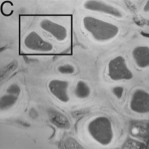Link to online paper: https://journals.asm.org/doi/10.1128/mBio.00127-11
Abstract
Carbonate chimneys at the Lost City hydrothermal field are coated in biofilms dominated by a single phylotype of archaea known as Lost City Methanosarcinales. In this study, we have detected surprising physiological complexity in singlespecies biofilms, which is typically indicative of multispecies biofilm communities. Multiple cell morphologies were visible within the biofilms by transmission electron microscopy, and some cells contained intracellular membranes that may facilitate methane oxidation. Both methane production and oxidation were detected at 70 to 80°C and pH 9 to 10 in samples containing the single-species biofilms. Both processes were stimulated by the presence of hydrogen (H2), indicating that methane production and oxidation are part of a syntrophic interaction. Metagenomic data included a sequence encoding AMP-forming acetyl coenzyme A synthetase, indicating that acetate may play a role in the methane-cycling syntrophy. A wide range of nitrogen fixation genes were also identified, many of which were likely acquired via lateral gene transfer (LGT). Our results indicate that cells within these single-species biofilms may have differentiated into multiple physiological roles to form multicellular communities linked by metabolic interactions and LGT. Communities similar to these Lost City biofilms are likely to have existed early in the evolution of life, and we discuss how the multicellular characteristics of ancient hydrogen-fueled biofilm communities could have stimulated ecological diversification, as well as unity of biochemistry, during the earliest stages of cellular evolution. IMPORTANCE Our previous work at the Lost City hydrothermal field has shown that its carbonate chimneys host microbial biofilms dominated by a single uncultivated “species” of archaea. In this paper, we integrate evidence from these previous studies with new data on the metabolic activity and cellular morphology of these archaeal biofilms. We conclude that the archaeal biofilm must contain cells that are physiologically and possibly genetically differentiated with respect to each other. These results are especially interesting considering the possibility that the first cells originated and evolved in hydrothermal systems similar to Lost City.
